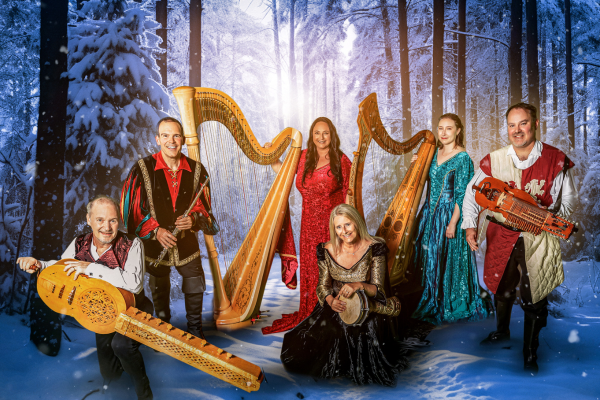
The first time I saw Winter Harp, I was mesmerized. I’ve seen countless shows over the course of my 40-year career as a professional musician, so it takes a lot to keep me transfixed through an entire production.
Winter Harp is one of those concerts you never forget. The combination of harps, rare medieval instruments, flutes, violin, singers, percussion, and heart-felt stories creates pure magic. The concert is also a feast for the eyes with gorgeous costumes and stunning backdrops giving it the look of a pre-Raphaelite painting.
But it seems I’m not the only one who got hooked on Winter Harp. Here in Vancouver, despite stiff competition from choirs and symphonies with massive marketing budgets, Winter Harp, with a shoestring budget, has consistently been one of the top holiday shows, selling out multiple concerts each December. Three decades after its debut, Winter Harp is celebrating a milestone anniversary this year that few artistic productions ever see.
Pappajohn says she has learned the importance of giving audiences what they want—not what you want—but you can stretch that boundary a bit.
Founder Lori Pappajohn laughs when I ask her about the backdrops, which are so real-looking that audiences gasp as the curtains open. “Once, a theater tech asked me why we didn’t have backdrops. Backdrops? I was floored. I’d never thought of backdrops,” recalls Pappajohn. “‘But we’d need a huge truck to move them,’ I countered, knowing nothing about backdrops. ‘Nope,’ he replied. ‘They fold down to the size of a large bag of dog food.’ Instantly I was sold.”
Besides adding backdrops, the ensemble kept adding instruments. “The more we added, the more I kept pulling my hair out arranging the music,” laughs Pappajohn. “It was easy when we started with just harps, flute, and percussion, but now with instruments as diverse as the hurdy-gurdy, nyckelharpa, organistrum, bass psaltery, concertina, and melodica (to name but a few)—well, need I say more?”
Winter Harp’s story is inspiring for young students starting on their musical journeys, and for more established musicians seeking to grow their audiences. When Winter Harp started, the production had no money, so Pappajohn and another member went up and down the streets themselves, plastering posters on lamp posts. Pappajohn sold CDs at the door before that first concert, then hurried backstage to change clothes for the performance. Marketing was hard work. Back then harps were rare, and no theater wanted to take the risk of a harp show. “One theater board exclaimed, ‘Harps? How boring!’” Pappajohn remembers. “But we proved them wrong with consistently sold-out shows there for some 20 years now.”
She notes that for harpists wanting to follow the same independent path as Winter Harp, it takes a lot of hard work. Your organizational skills need to be strong, and it helps if you enjoy those tasks, because administrative work can take 80–90 percent of your time.
Pappajohn says she has learned the importance of giving audiences what they want—not what you want—but you can stretch that boundary a bit. “We give people the familiar carols they love. But we also perform fiery flamenco and Middle Eastern pieces complete with dueling harps, dumbeks, and cajon. We want people to say: ‘Wow—harps can do that?!’”
There are currently two harpists in the ensemble, and they were both my students while studying at the University of British Columbia. Playing lever harp is Hayley Farenholtz, who also doubles on penny whistle and psaltery. Lani Krantz, who plays extra second and acting principal harpist for the Vancouver Symphony, is Winter Harp’s pedal harpist. Like Pappajohn, she has that rare ability to be promoter/manager/producer with a quick change into performer. Krantz has taken over as director while Pappajohn focuses on arrangements and producing the next album—Winter Harp’s 13th.
While the ensemble generally features two harps on stage, one year I was delighted to see four with both harper/storyteller Patrick Ball and harpist Kim Robertson joining the tour.
Over its three decades, Winter Harp has substantially contributed to the harp community in Western Canada. Countless numbers of adults and children have become harpists after seeing the show. Inevitably my phone rings with these star-struck wannabees seeking lessons. And it is almost impossible to push a harp down the streets of Vancouver without someone stopping to mention they have seen the show.
“One hot summer day downtown, a woman came up to me and said, ‘I was at your concert. It changed my life.’ I have heard that from numerous people over the years,” says Pappajohn. “I guess the ancient sound of the harps, combined with the heartfelt stories, reach deep into people’s hearts and cause things to shift.” •







